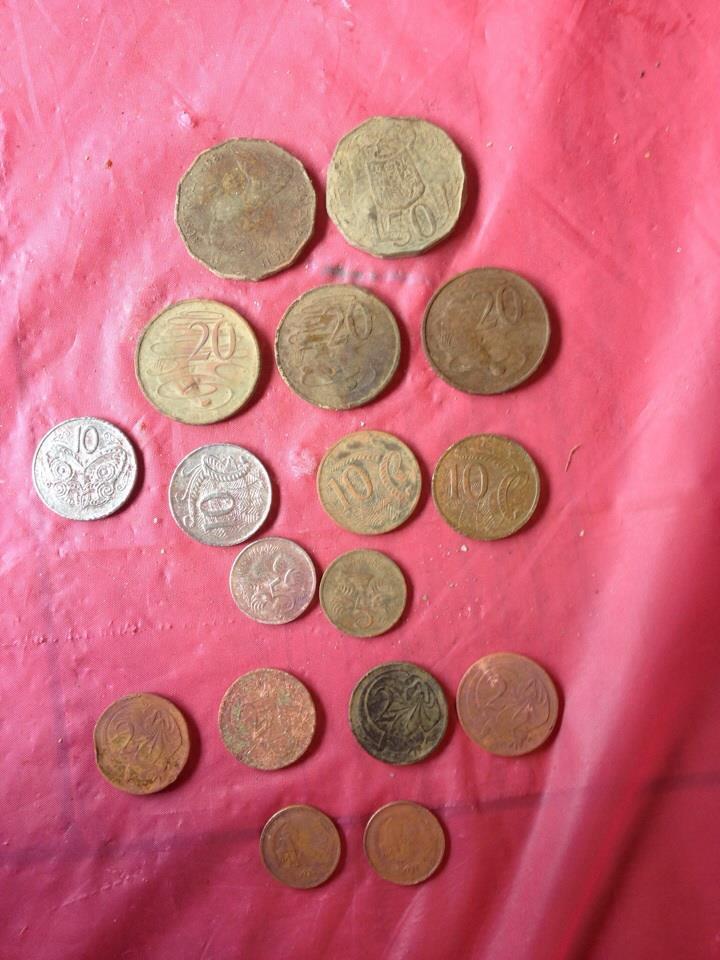- Joined
- Oct 15, 2013
- Messages
- 192
- Reaction score
- 23
The other week I went down to the local creek bank. Got a solid hit on my detector and started digging. It didn't take too long to dig far enough for my handheld pinpointer the detect the metal object. It went off in every direction that I touched so I knew it was a large object.
I dug a bit further and noticed that it was a big piece of metal and decided to abandon the dig thinking it was just your standard piece of trash. I filled the small hole back in and walked off to try my luck elsewhere. As I did so I got this nagging feeling that I should go back and dig it up. The surface of the object that I had found obviously wasn't a can and didn't seem like a piece of modern trash. Being right next to the creek I started thinking that perhaps it was a relic from canberra's pastoral days. I went back and decided to dig some more.
An hour later, using my trusty, dull $3 garden trowel I managed to dig up a substantial amount of the item revealing a curved thick sheet of metal. It wasnt jagged at all but had a smooth surface all around. My heart was racing, did a find a buried lockbox? The shape of the item i had managed to uncover reminded me of the curved lid that old chests used to have.

The area was also conspicuous. Right near a creek, perfectly In between a strand of four large old trees. It's location was smack in the center of the two middle most trees. In my eyes it was a perfect marker to remember where you had buried something of value, and indeed, in the old days people did use natural landmarks to help identify where they stashed their prized goods.
I dug further, cutting through roots, digging up all manner and sizes of rocks, revealing more and more of the large object. By now I was about an hour and a half into the dig (bemoaning the fact that I did not bring a shovel or a pick - or even something a little better than a blunt gardening trowel.
As I dug further I managed to reveal the edges of the item, while it was reasonably thick there were no sides to form a box, and the shape was all wrong. I resigned myself to the fact that it wasn't the buried treasure that I had convinced myself of. but having put so much time and effort into trying to dig this sucker out I decided to continue.... In the end, after consultation with my husband, we decided it was a plough blade. It had the right shape and dimensions used for blades during the 1900s. Unfortunately I ended up hitting large rocks that I was unable to crack or budge with the tools on hand and had to abandon the dig. I know exactly where it is though, using the conspicuous tree markers, if I ever decide to complete the excavation.



I dug a bit further and noticed that it was a big piece of metal and decided to abandon the dig thinking it was just your standard piece of trash. I filled the small hole back in and walked off to try my luck elsewhere. As I did so I got this nagging feeling that I should go back and dig it up. The surface of the object that I had found obviously wasn't a can and didn't seem like a piece of modern trash. Being right next to the creek I started thinking that perhaps it was a relic from canberra's pastoral days. I went back and decided to dig some more.
An hour later, using my trusty, dull $3 garden trowel I managed to dig up a substantial amount of the item revealing a curved thick sheet of metal. It wasnt jagged at all but had a smooth surface all around. My heart was racing, did a find a buried lockbox? The shape of the item i had managed to uncover reminded me of the curved lid that old chests used to have.

The area was also conspicuous. Right near a creek, perfectly In between a strand of four large old trees. It's location was smack in the center of the two middle most trees. In my eyes it was a perfect marker to remember where you had buried something of value, and indeed, in the old days people did use natural landmarks to help identify where they stashed their prized goods.
I dug further, cutting through roots, digging up all manner and sizes of rocks, revealing more and more of the large object. By now I was about an hour and a half into the dig (bemoaning the fact that I did not bring a shovel or a pick - or even something a little better than a blunt gardening trowel.
As I dug further I managed to reveal the edges of the item, while it was reasonably thick there were no sides to form a box, and the shape was all wrong. I resigned myself to the fact that it wasn't the buried treasure that I had convinced myself of. but having put so much time and effort into trying to dig this sucker out I decided to continue.... In the end, after consultation with my husband, we decided it was a plough blade. It had the right shape and dimensions used for blades during the 1900s. Unfortunately I ended up hitting large rocks that I was unable to crack or budge with the tools on hand and had to abandon the dig. I know exactly where it is though, using the conspicuous tree markers, if I ever decide to complete the excavation.












